
Buchenwald was a Nazi concentration camp established on Ettersberg hill near Weimar, Germany, in July 1937. It was one of the first and the largest of the concentration camps within Germany's 1937 borders. Many actual or suspected communists were among the first internees.

Wing Commander Forest Frederick Edward Yeo-Thomas,, known as "Tommy", was a British Special Operations Executive (SOE) agent in the Second World War. Codenamed "Seahorse" and "Shelley" in the SOE, Yeo-Thomas was known by the Gestapo as "The White Rabbit". His particular sphere of operations was Occupied and Vichy France. He was one of the most highly decorated agents in the Second World War.

Fresnes Prison is the second largest prison in France, located in the town of Fresnes, Val-de-Marne, south of Paris. It comprises a large men's prison of about 1200 cells, a smaller one for women and a penitentiary hospital.
Roy Allen (1918–1991) was an American, born in the north Philadelphia neighborhood of Olney. He was a bomber pilot during World War II shot down over France and sent to Buchenwald concentration camp.
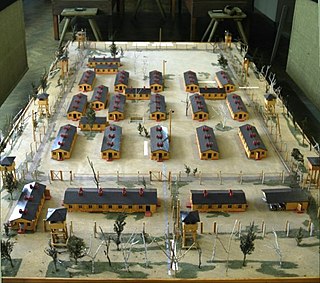
Stalag Luft III was a Luftwaffe-run prisoner-of-war (POW) camp during the Second World War, which held captured Western Allied air force personnel.

Nazi exploitation is a subgenre of exploitation film and sexploitation film that involves Nazis committing sex crimes, often as camp or prison overseers during World War II. Most follow the women in prison formula, only relocated to a concentration camp, extermination camp, or Nazi brothel, and with an added emphasis on sadism, gore, and degradation. The most infamous and influential title is a Canadian production, Ilsa, She Wolf of the SS (1974). Its surprise success and that of Salon Kitty and The Night Porter led European filmmakers, mostly in Italy, to produce similar films, with just over a dozen being released over the next few years. Globally exported to both cinema and VHS, the films were critically attacked and heavily censored, and the sub-genre all but vanished by the end of the seventies.
Squadron Leader Roger Joyce Bushell was a South African-born British military aviator. He masterminded the "Great Escape" from Stalag Luft III in 1944, but was one of the 50 escapees to be recaptured and subsequently murdered by the Gestapo.

Lieutenant-Colonel Claude Cunningham Bruce Marshall was a prolific Scottish writer who wrote fiction and non-fiction books on a wide range of topics and genres. His first book, A Thief in the Night came out in 1918, possibly self-published. His last, An Account of Capers was published posthumously in 1988, a span of 70 years.
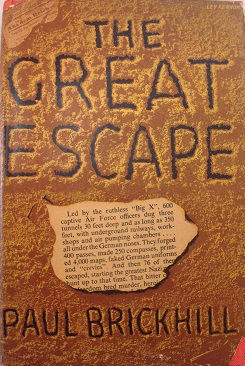
The Great Escape is a 1950 book by Australian writer Paul Brickhill that provides an insider's account of the 1944 mass escape from the German prisoner of war camp Stalag Luft III for British and Commonwealth airmen. As a prisoner in the camp, he participated in the escape plan but was debarred from the actual escape 'along with three or four others on grounds of claustrophobia'. The introduction to the book is written by George Harsh, an American POW at Stalag Luft III. This book was made into the 1963 film The Great Escape.
Stalag Luft I was a German World War II prisoner-of-war (POW) camp near Barth, Western Pomerania, Germany, for captured Allied airmen. The presence of the prison camp is said to have shielded the town of Barth from Allied bombing. About 9,000 airmen – 7,588 American and 1,351 British and Canadian – were imprisoned there when it was liberated on the night of 30 April 1945 by Soviet troops.
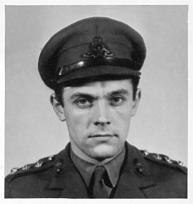
Henri Leonard Thomas Peulevé DSO MC was a Special Operations Executive agent who undertook two missions in occupied France and escaped from Buchenwald concentration camp.
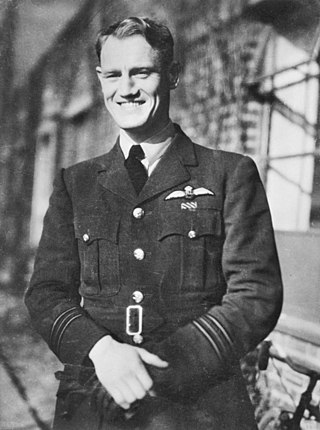
Phillip John Lamason, was a pilot in the Royal New Zealand Air Force (RNZAF) during the Second World War, who rose to prominence as the senior officer in charge of 168 Allied airmen taken to Buchenwald concentration camp, Germany, in August 1944. Raised in Napier, he joined the RNZAF in September 1940, and by April 1942 was a pilot officer serving with the Royal Air Force in Europe. On 8 June 1944, Lamason was in command of a Lancaster heavy bomber that was shot down during a raid on railway marshalling yards near Paris. Bailing out, he was picked up by members of the French Resistance and hidden at various locations for seven weeks. While attempting to reach Spain along the Comet line, Lamason was betrayed by a double agent within the Resistance and seized by the Gestapo.
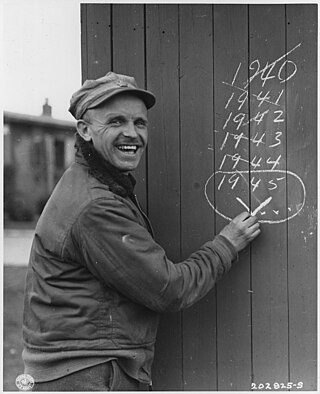
Dulag Luft were Prisoner of War (POW) transit camps for German-captured members of the Air Force during World War II. Their main purpose was to act as collection and interrogation centres for newly captured aircrew, before they were transferred in batches to the permanent camps.
Between 20 August and 19 October 1944, 168 Allied airmen were held prisoner at Buchenwald concentration camp. Colloquially, they described themselves as the KLB Club. Of them, 166 airmen survived Buchenwald, while two died of sickness at the camp.
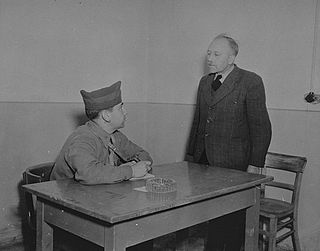
Berga an der Elster was a subcamp of the Buchenwald concentration camp. The Berga forced labour camp was located on the outskirts of the village of Schlieben. Workers were supplied by Buchenwald concentration camp and from a prisoner-of-war camp, Stalag IX-B; the latter contravened the provisions of the Third Geneva Convention and the Hague Treaties. Many prisoners died as a result of malnutrition, sickness, and beatings, including 73 American POWs.

Edgar Spottiswoode Humphreys, known as Hunk, was a British Bristol Blenheim bomber pilot who was taken prisoner during the Second World War. He took part in the 'Great Escape' from Stalag Luft III in March 1944, but was re-captured and subsequently shot by the Gestapo.
Arthur Steele was a British soldier who joined Special Operations Executive (SOE) to operate in occupied France during the Second World War as a wireless operator carrying out sabotage and spying missions until he was taken prisoner. He was tortured for information unsuccessfully by the Gestapo and subsequently killed by the SS.
Berthe Fraser was a French Resistance agent who fought the Germans and helped more than 100 allied airmen escape during the Second World War. She spent two years of the war in prison, in one case being tortured for 28 days. She was awaiting execution by the Gestapo in September 1944 but was saved by Allied soldiers who drove away her captors.
The White Rabbit is a 1967 British four-part TV series starring Kenneth More. It is based on the book by Bruce Marshall. It is the last of three mini series More starred in for BBC2 in succession.













